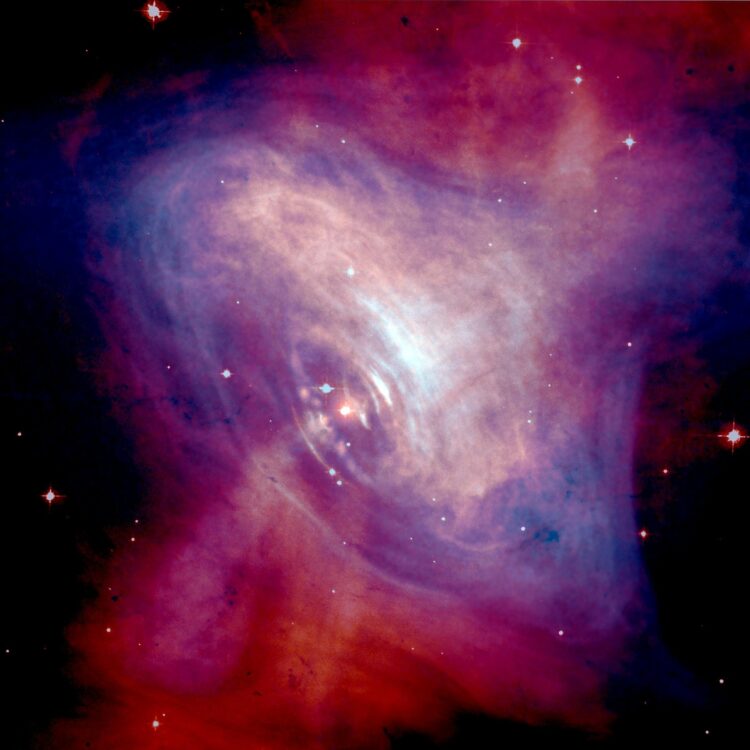The night sky is breathtakingly captivating. It entrances viewers with twinkling lights that allow for navigation, make shapes, and tell stories. As technology advances, people are even able to put manmade lights into the sky in the forms of planes or satellites. Often those observing the sky try to tell the two apart, which is possible by detecting movement or flashes of light. However, sometimes these flashes of light are indicators of a star long forgotten whose remains spin so fast that they appear on Earth as a light turning on and off.
These flashes of light are known as pulsars, named for how they appear to pulse in the night sky. Pulsars are not actually stars, rather they are the remains of one. When a massive supergiant star collapses, the stellar death creates an explosion known as a supernova, and the dense amount of material collected at the center can form a neutron star. Should the material be highly magnetic, there is a chance that the neutron star begins to rotate, creating a pulsar.
While a millisecond pulsar devours its companion star, the binary system is referred to as a spider system.
It is suspected that pulsars siphon matter and momentum from a nearby companion star, increasing its spin rate; this would explain why pulsars have different speeds. The slowest pulsars ever detected spin once per second and are aptly named slow pulsars. Fast pulsars on the other hand can spin hundreds of times a second. Millisecond pulsars are the fastest, spinning with millisecond rotation periods. While a millisecond pulsar devours its companion star, the binary system is referred to as a spider system. Depending on the size of the companion star, the system is either named a black widow or a redback. This is derived from the two species of spiders whose females are observed to consume smaller males after mating, similar to how the pulsar “consumes” the lighter companion star.
While fascinating, few of these spider systems have been found because plasma from the companion star can hide pulsations of the pulsar, disguising them in radio pulsar surveys. However, that never stopped astronomers from speculating some celestial objects to be spider systems.
While fascinating, few of these spider systems have been found because plasma from the companion star can hide pulsations of the pulsar, disguising them in radio pulsar surveys.
One such example is the source now known as PSR J2039-5617 whose existence has been known since June of 2014. Originally observed as a source of gamma rays, astronomers quickly analyzed its X-ray emissions and predicted it to be a redback. However, with the companion star’s plasma blocking the millisecond pulsar’s radio pulsations, it was impossible for astronomers to reclassify the object.
Millisecond pulsars emit more than just radio pulsations–they also emit gamma-ray pulsations. Gamma-ray emissions are unique in the sense that they do not experience the same distortion and are easily detected by the Fermi Gamma-ray Space Telescope’s on-board Large Area Telescope (LAT). As such, searches for isolated millisecond pulsars are now streamlined. Binary spider systems, on the other hand, require some additional orbital parameters to be set. These parameters are necessary as they account for the Doppler shift, which would cause the pulsations to appear smeared out on readings if not accounted for.
The scientist team at the Albert Einstein Institute compared periodic X-rays and intensity of light measured to determine the necessary parameters including orbital period and spin frequency. The sky positions scanned were determined by precise Gaia data.
Using these constraints, the scientists used the distributed volunteer computing system Einstein@Home to comb through data gathered by Fermi since its launch in 2008. The website splits data into millions of smaller chunks that are able to be processed on an average computer within a few hours, computing data while volunteer’s computers are idle.
Einstein@Home splits data into millions of smaller chunks that are able to be processed on an average computer within a few hours, computing data while volunteer’s computers are idle.
The search revealed a signal with a spin frequency of 377 Hz, which was used along with the companion star’s radial velocity measurements to calculate the mass ratio of the companion star to the pulsar. With the mass ratio stating that the companion star is both larger and of higher mass than those in black widow systems, the redback status of the system was confirmed, officially naming the source PSR J2039-5617.
This redback identification is the first to be completed through gamma-ray pulsations, leading to what is hopefully a new way to properly classify pulsars. With more pulsars to study comes many new insights. For example, pulsars can be used as clocks, tell us about gravitational waves, and may lead to the discovery of alien planets. While often overlooked as artificial, these flashes of light can uncover mysteries about the universe.
Monthly Notices of the Royal Astronomical Society (2020) DOI: 10.1093/mnras/staa3484
Image source: Pixabay.

